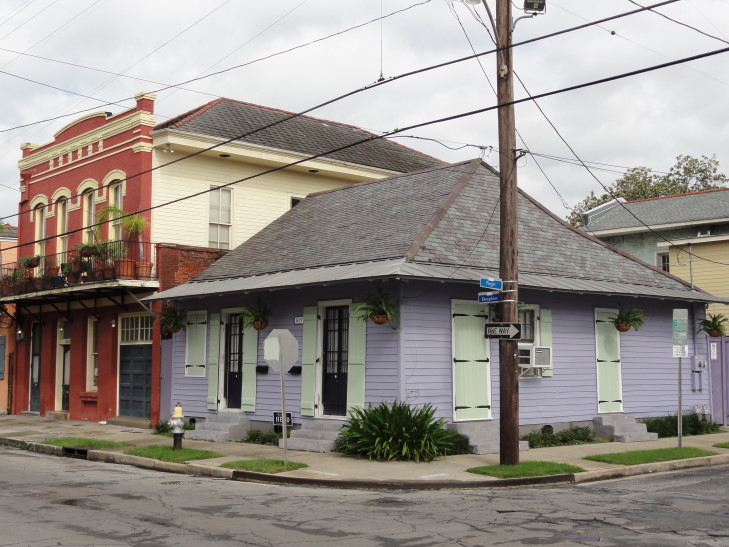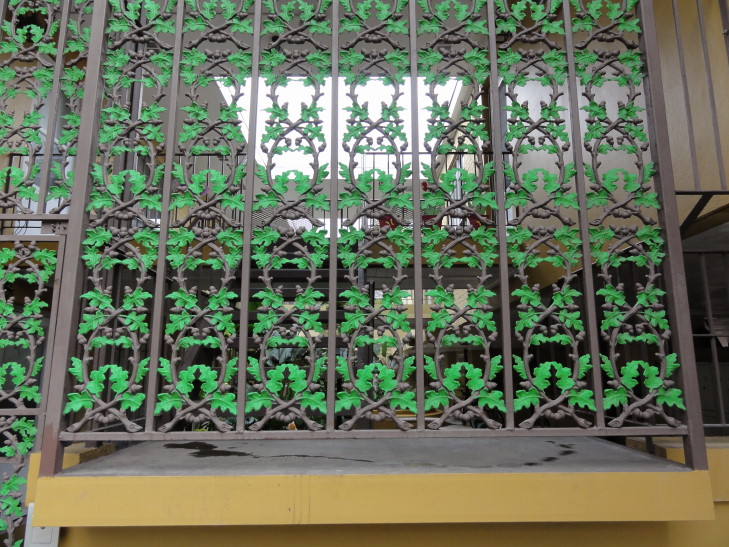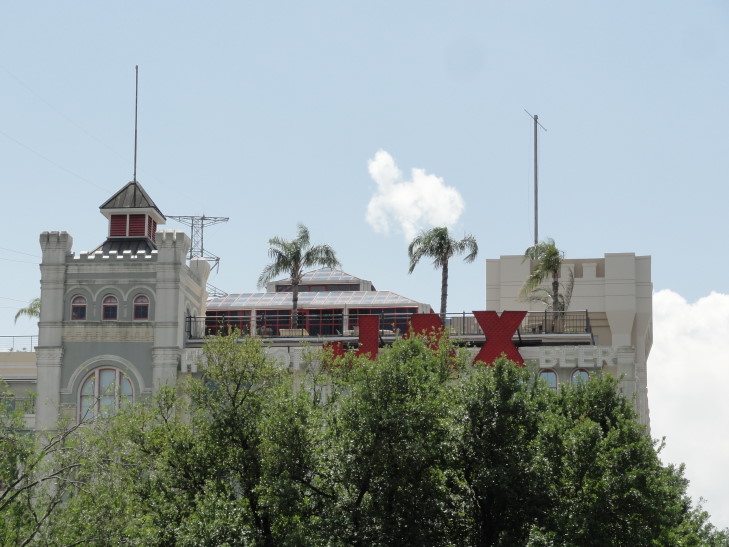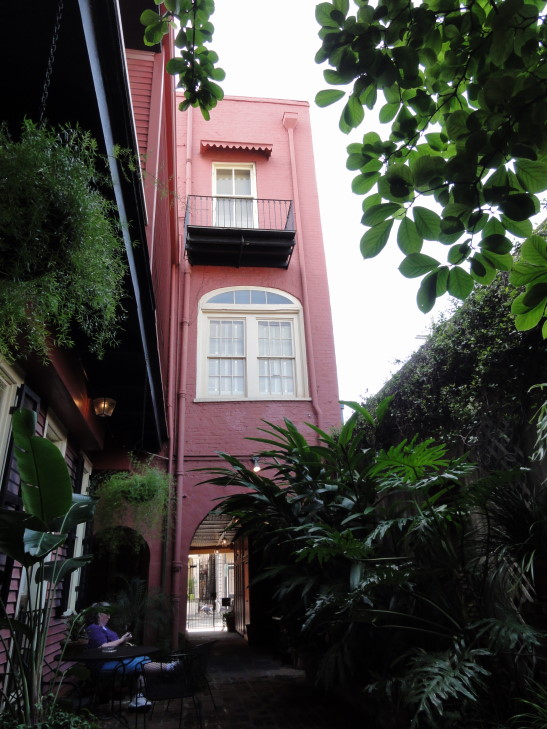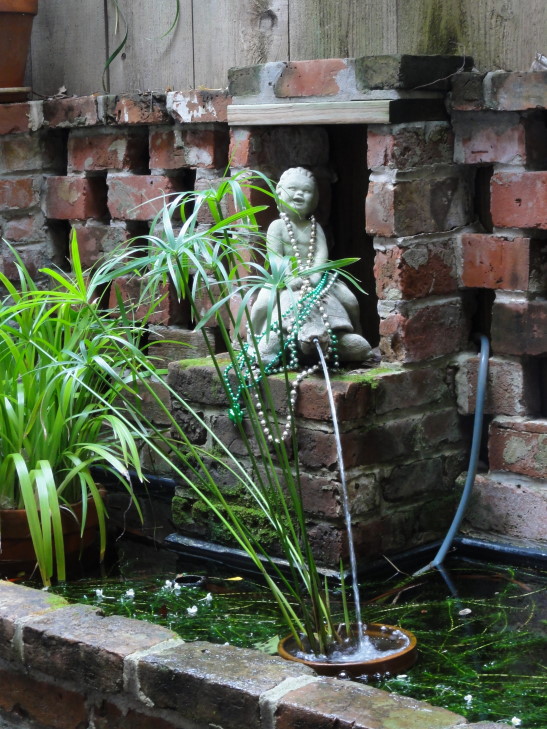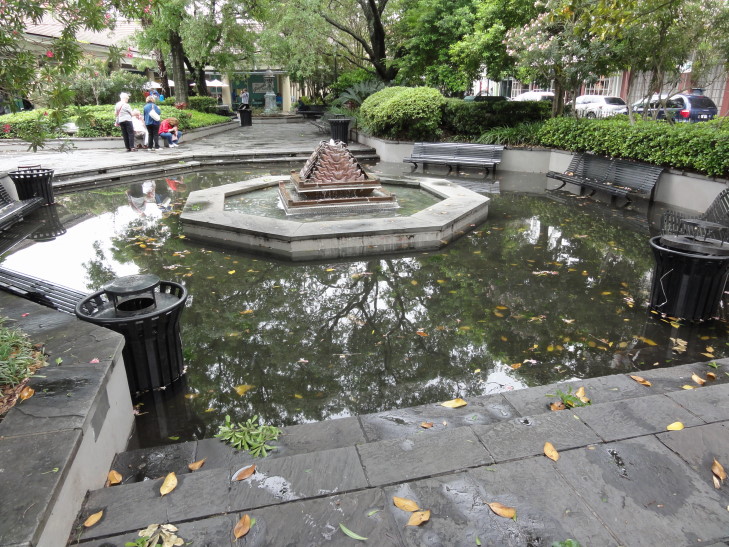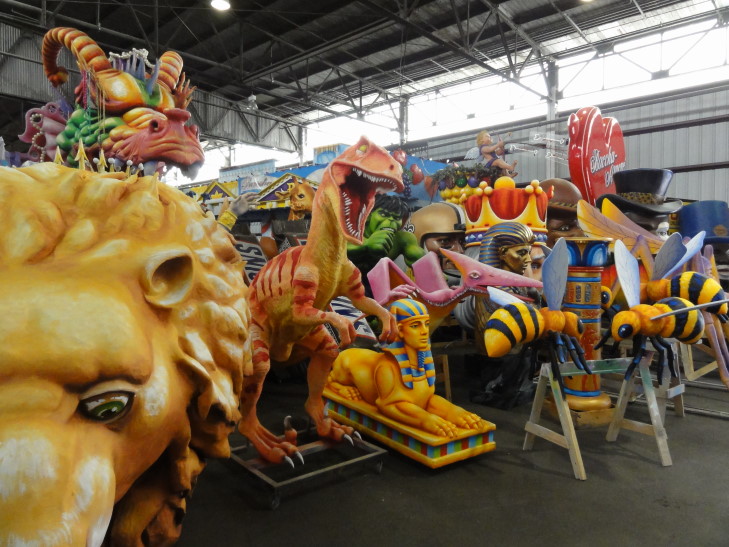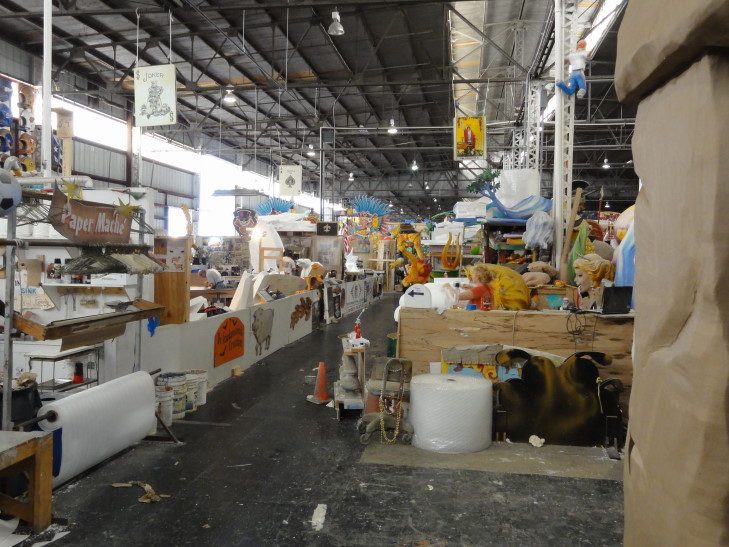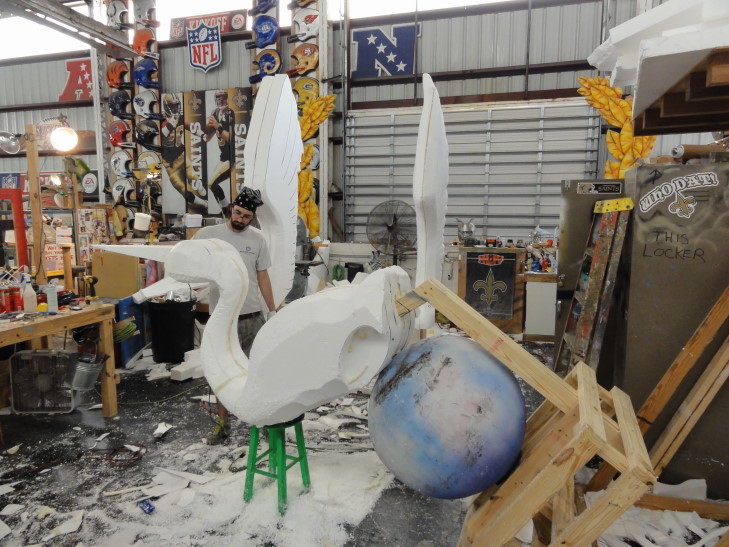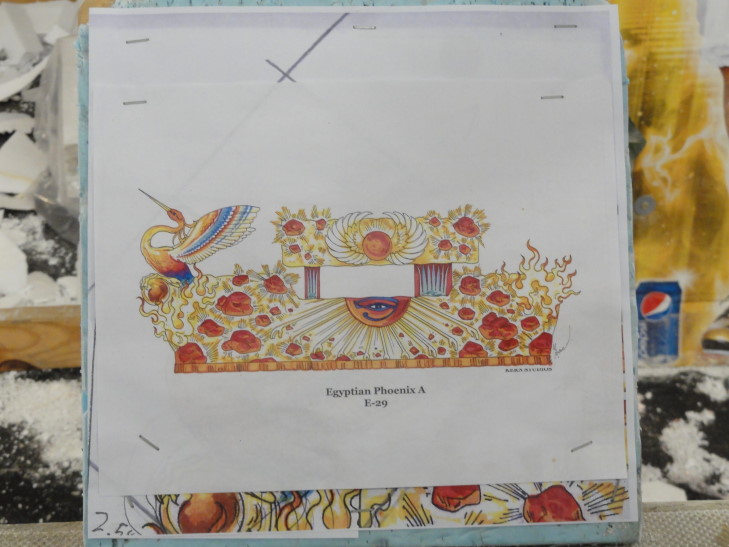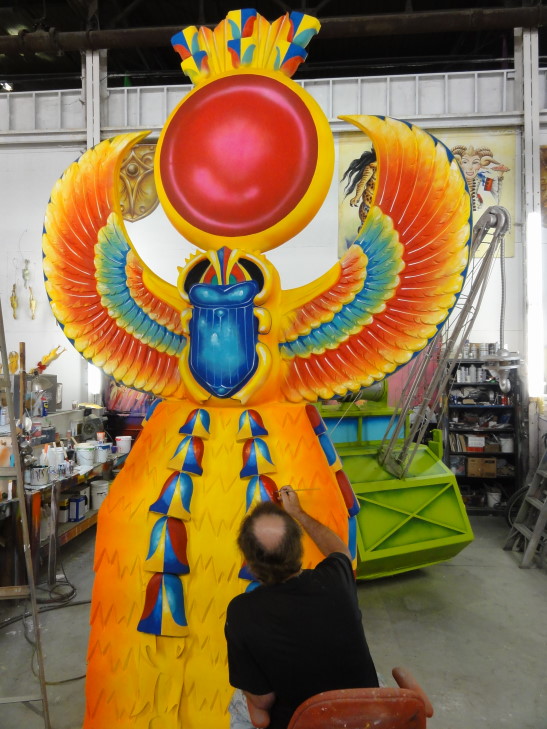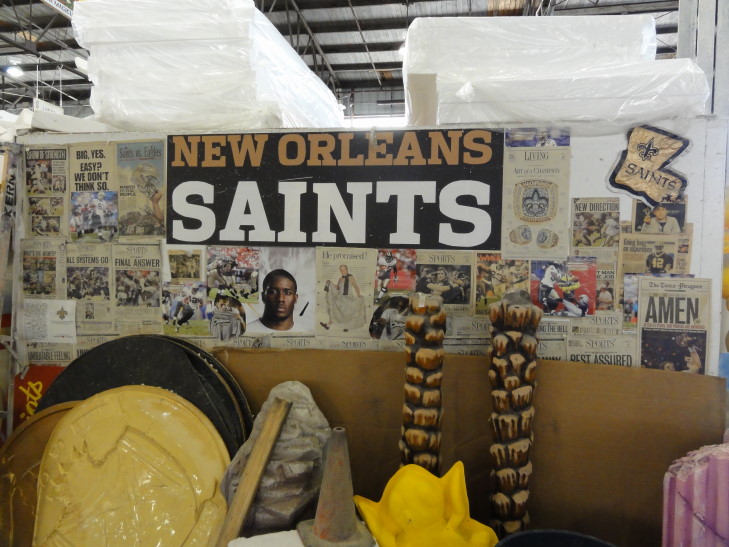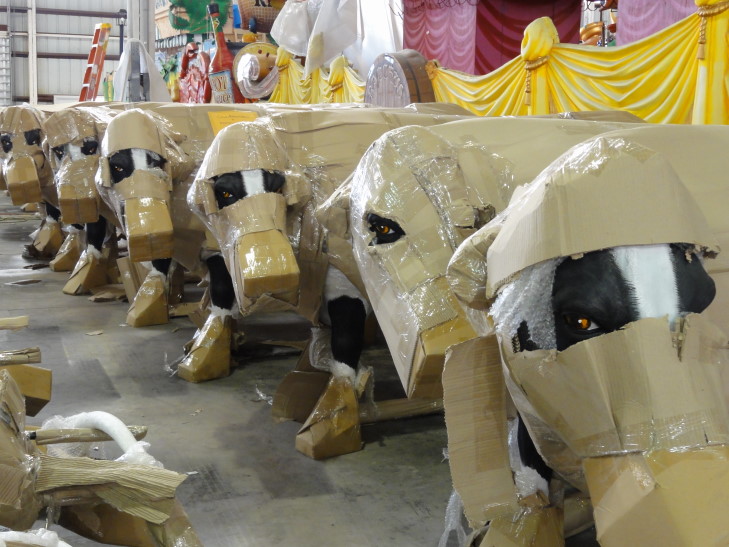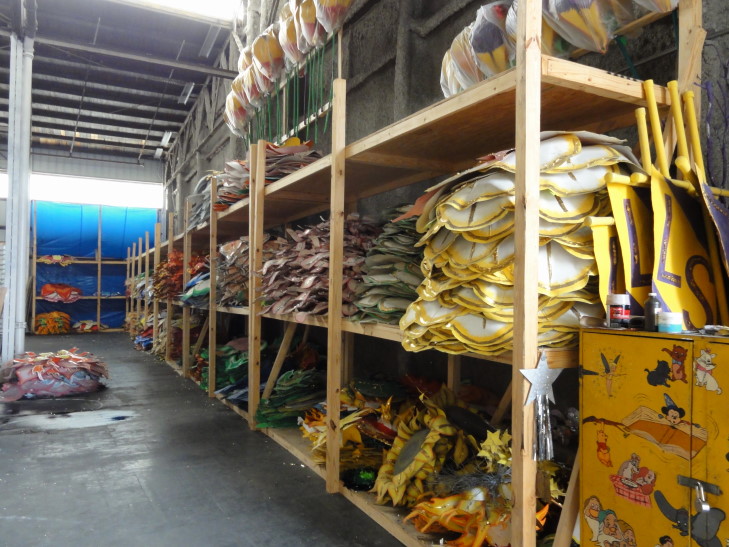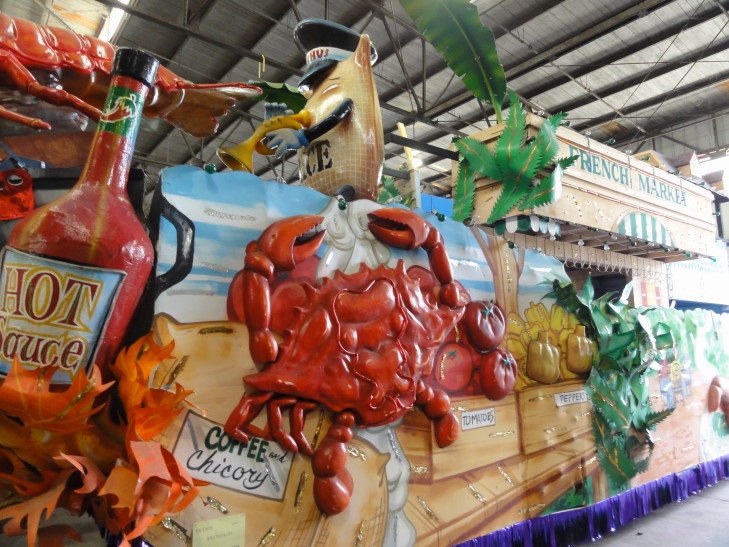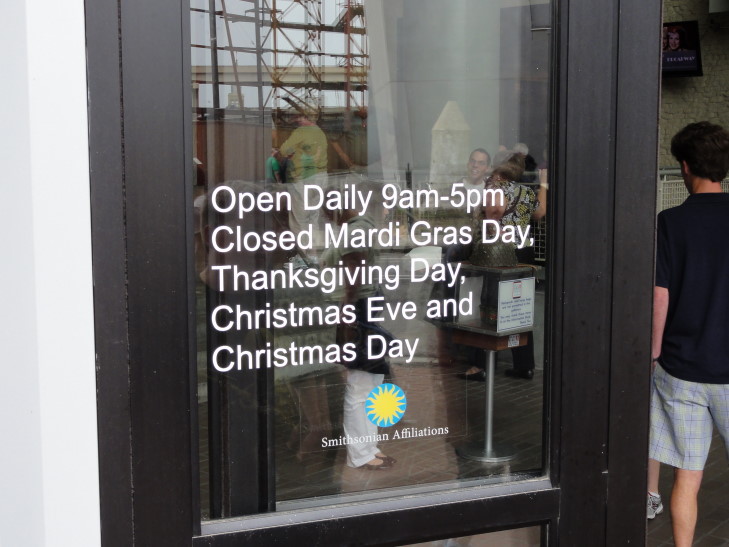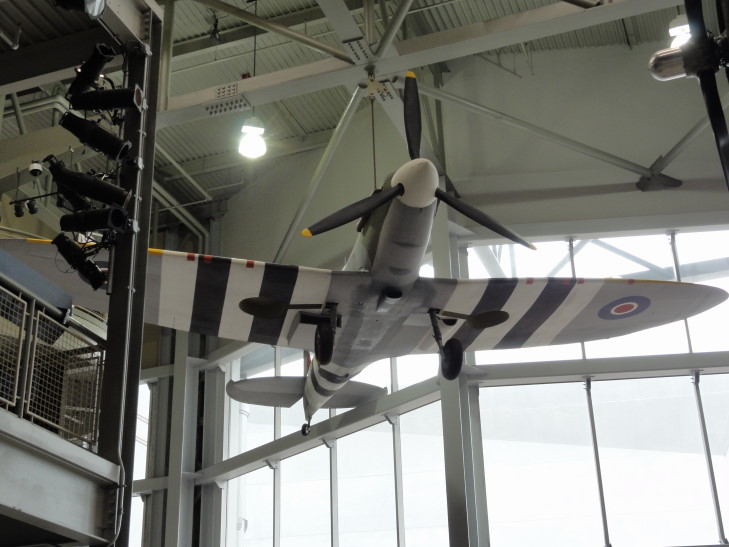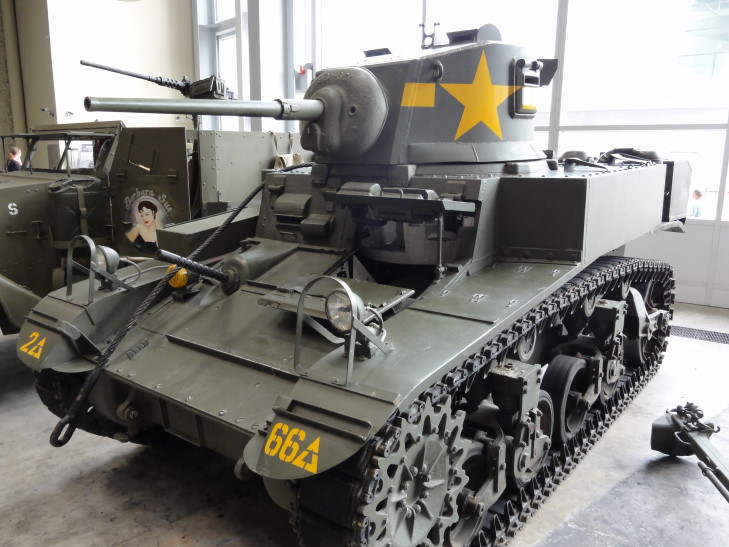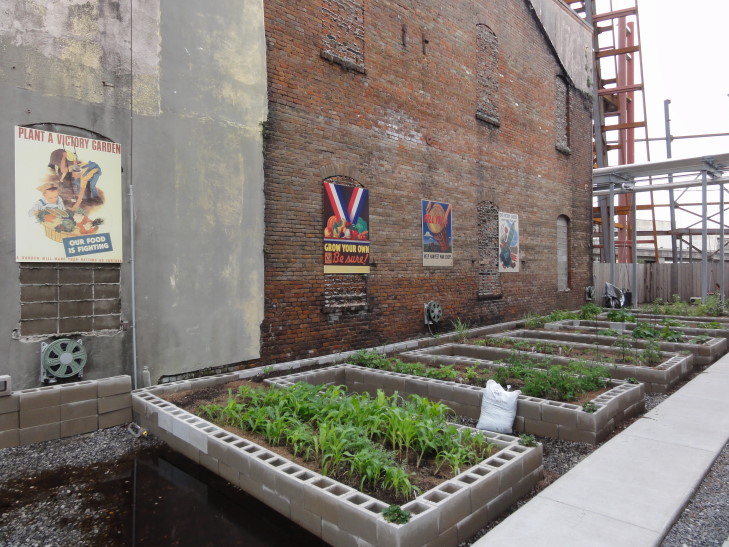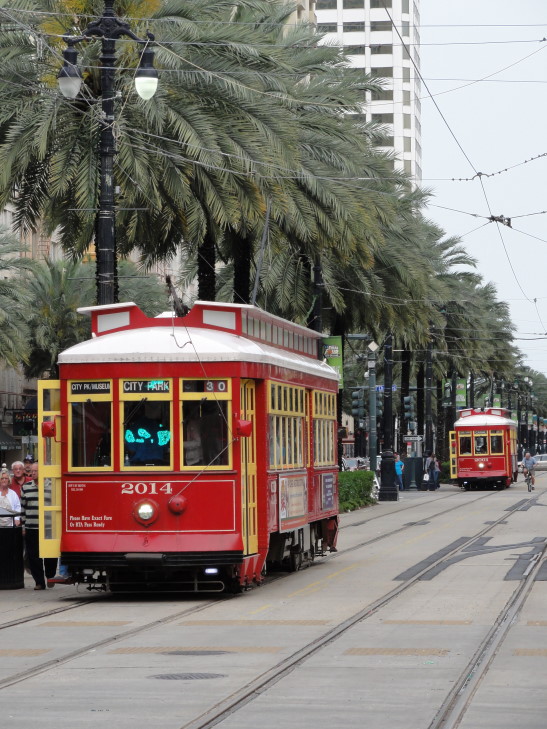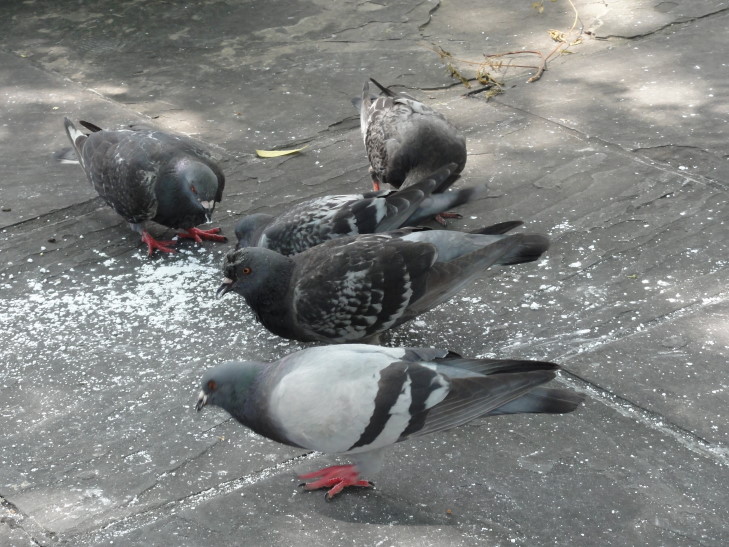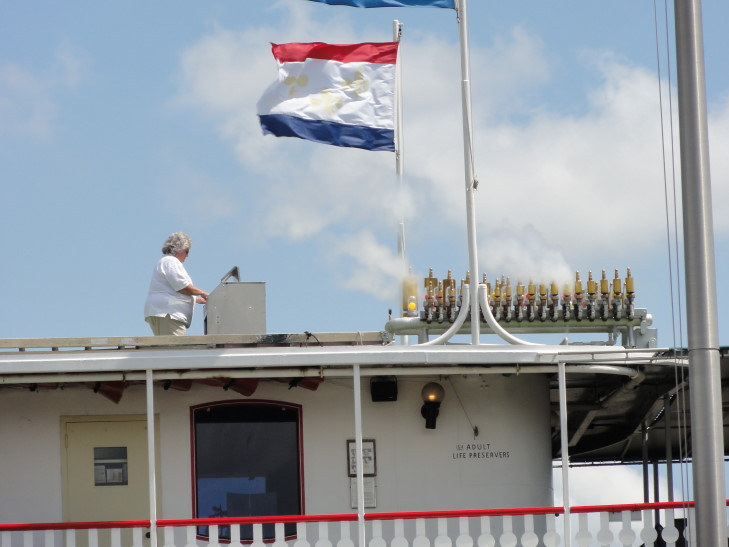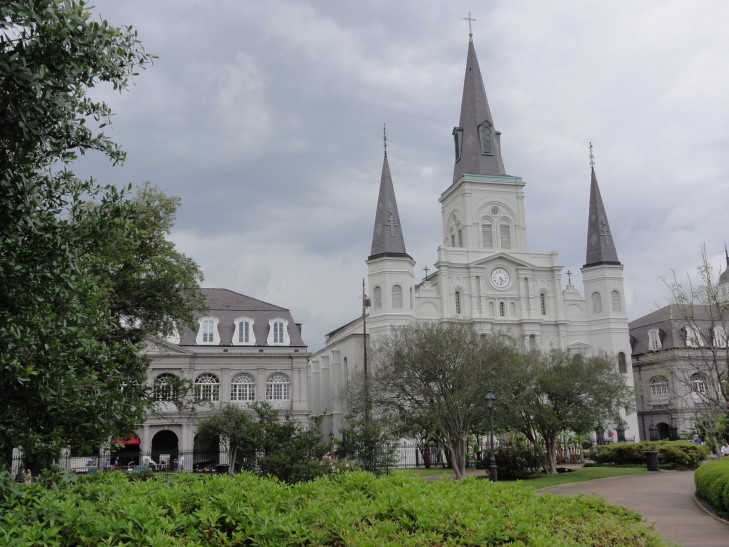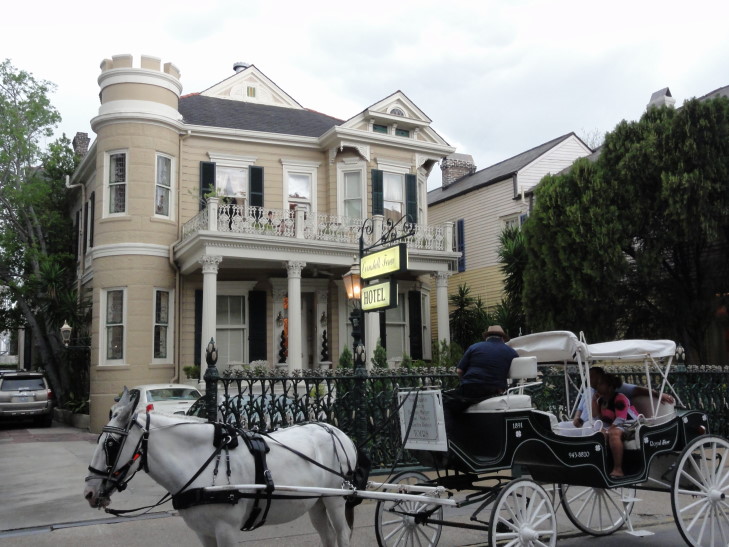Woke up and the six of us headed to breakfast at the Croissant d’Or on Ursaline. Unfortunately it was closed on Tuesdays so we decided upon Cafe Beignet all the way down on Royal. I had a breakfast croissant with bacon, scrambled eggs, and white cheddar cheese — yummy!
Afterwards Mom and Dad took Addison shopping for a bit while Michelle, Genetta, and I also did some of our own. Michelle looked at lamps at a store that sold lots of various home accessories like fountains, bar stools, and yes lamps. Tiffany-like lamps. It’s like her kryptonite. There was a beautiful one in there and Michelle succumbed once it was offered at half-price with free shipping. It really is a beautiful lamp, hopefully it’ll make it to North Carolina in one piece.
We also did some shopping on Decatur at some places Genetta saw the other night and really wanted to visit. We went into a place called Jazz Funeral and bought some shirts and other stuff. In another store we saw a really cool shirt with Boba Fett in a gold suit and the NFL Saints symbol on his shoulder. I’m sure it was licensed by Lucas, haha. We picked that up for Addison, as we knew he’d love it. We even managed to find something in one of those Christmas-themed stores.
Afterward the three of us went to Cafe Du Monde (yes, again) for a couple of beignets and some frozen cafe au lait. We sat inside the air conditioned part of the place and it was wonderful. Did capture a glimpse behind the scenes while waiting for the bathroom, though. Not an easy job. Very, very loud clattering of dishes being stacked (it is a wonder that dishes last more than a day or two there) and all of the waiters / waitresses lined up to pay for their orders. That’s right, they pay for the orders out of pocket and then go collect from the patrons — all the while hoping they don’t get shorted, or drop the order, or what-not. It seemed to be a brutal pace as well.

Another shot of Saint Louis Cathedral and Jackson Square
After Cafe Du Monde we three walked up to the kiosk for the Natchez and Gray Line tours to wait for Mom, Dad, and Addison. They showed up shortly thereafter and we bought tickets for a 1p cemetery tour. As the Final Four was over it was markedly less crowded and the bus itself (one of those short tour buses) was only half full.
The ride up to the Basin Street Visitor Center (in an old train terminal) didn’t take long. Along the way the guide, a short blonde-haired New Orleans native, filled us in on the history of New Orleans, from discovery of the Mississippi by the Spanish in the 1540s through founding by the French in the early 1700s then rule by the Spanish then the French again prior to purchase by the Americans. Apparently many of the early settlers to New Orleans were told that the colony was above sea level (nope) and that there were gold and silver deposits all over (double nope).
The colony did relatively well until it was struck by Yellow Fever in the late-1700s. The tour guide went into great detail on the course of the disease as well as the efforts to treat it — blood letting, glass heated to super hot then rolled on the skin to remove evil vapors, etc. I think she enjoyed watching some of the people squirm.
Obviously calamities like the Yellow Fever outbreaks and fire (such as the Good Friday fire of 1788 that wiped out much of the town) created a significant problem — what to do with all of the bodies. Earlier burial methods were problematic — originally bodies were interred in the levee but spring floods would bring them floating up. Bodies were later interred in the swamps to the northwest of town (which then was mainly just the French Quarter) which helped somewhat as the alligators would eat any that floated to the surface.
The fire of 1788, however, provided an opportunity for the Spanish to re-imagine the town. They built a cemetery just to the northwest of the quarter, Saint Louis Cemetery No. 1. As it wouldn’t do to inter a body without a service but holding services at Saint Louis Cathedral was ruled out (due to fear of any diseases spreading) a chapel was built adjacent to the cemetery. The cemetery originally spanned six blocks but has since been reduced to just one via several public works projects in the mid-1900s. In fact a tomb at the very entrance once stood in the middle according to historic documents!

Tombs at Saint Louis Cemetery No. 1
As the water table is very close to the surface (in many places no farther than a foot down) it became necessary to bury the dead above ground in tombs. Unfortunately, though, southeastern Louisiana also lacks stone. So the tombs were made of bricks made from Mississippi river mud mixed with oyster shells. These deteriorate over time, however, leading the cemetery to be in a state of disrepair in modern times, though there is an organization called Save Our Cemeteries that raises funds to renovate a tomb or two a year (at an average cost of $45,000 or so, ouch!).

Tombs at Saint Louis Cemetery No. 1
As more and more people were buried it became necessary to make room. Bodies were to be interred by law for one year before they could be disturbed, under the belief that a year would be sufficient for whatever disease killed the person to be gone. An extra day was often taken, meaning that the year-and-a-day deceased were disinterred and moved elsewhere in the tomb or were moved to be interred in the walls of the cemetery. Space in the cemetery is less an issue now that Catholics are allowed to be cremated in more recent times (a majority of New Orleans is Catholic).

Tombs at Saint Louis Cemetery No. 1
The guide pointed out several tombs that had attracted the attention of the local homeless or “emo and goth” kids. They had been adorned with Mardi Gras beads, had candles lit in front, sometimes a mirror placed in front, and other such things (sadly including graffiti) done to them.

Decorated tomb
In the back of the cemetery was a separate section for the Protestants, many of whom were Americans flooding into the area after the Louisiana Purchase transferred the city to the United States. Protestants preferred to be buried underground and their coffins were put into a shaft and capped with a marble slab. In the days before the water level under the city was better regulated the rising and falling water level would cause the floating coffins to sometimes bump against the marble slab, creating a dull knocking sound. Spooky!

Tombs at Saint Louis Cemetery No. 1
Behind the Protestant section were projects built on top of the famed Storyville. They have been abandoned since Katrina, however, as they were infested with mold. Plans to tear them down have been in place for a while but they remain there still.
Next we came upon the memorial to those that lost their lives in the Battle of New Orleans, which occurred on January 8, 1815. Though the War of 1812 had already concluded and a treaty had been signed the combatants were not aware. New Orleans sought the help of Andrew Jackson and the pirate Jean Lafitte in defeating a far superior British force. Lafitte was able to get a pardon for his brother, Pierre, himself, and his men for the acts of piracy they had recently been accused of. The battle was an overwhelming victory for the Americans with only 13 dead to the British’s 291. The memorial incorporated cannon into its design as Lafitte’s men were experienced artillerymen and instrumental in defeating the British.

Tombs at Saint Louis Cemetery No. 1
Next we visited the tomb of Bernard de Marigny, a French-Creole man that owned a huge tract of land east of the French Quarter. Our guide told a story about his family entertaining the future king of France by serving a 17 course meal (it took six and a half hours to eat!) on a total of one hundred solid gold plates. Afterward they announced that the plates would never again be used out of respect for the future king and were tossed in the river — where a hidden net scooped them up lest they be lost. After his father died in 1800 he was shipped off to Europe where he learned Hazard, a game he brought back to New Orleans that would later be known as Craps. Increasingly in debt due to his gambling, de Marigny sold off many small pieces of his land in the area now known as Faubourg Marigny. He died penniless in 1868.
Our guide took us past a pyramid-shaped tomb. That one belongs to Nicholas Cage, who apparently believes strongly in mysticism and the power of the pyramid. Five of his cats are already buried there, but he’s still out and about making movies. Maybe the next National Treasure movie should involve his tomb!
It was sweltering hot at the cemetery. No trees and the short tombs providing scant shade. The sun’s rays bounced all over the place off of the often bleached white tombs. As the cemetery was back from the river a good distance there was no breeze to speak of. The guide told us that often the insides of the tombs would heat to 400F or more.
One tomb that did provide welcome shade, however, was one of the ones built for Italians that belonged to a benevolent society. Sadly the designer and architect of the tomb, both Italians, died of Yellow Fever just a week before they were to sail home. There were tombs for other immigrant groups as well, but this one became famous due to the movie Easy Rider. In it Dennis Hopper is seen sitting in a lap of the tomb’s statue. About the time the movie was made the statue’s head disappeared. Many still believe Mr. Hopper took it, something he vehemently denies. The film changed the way that movies were made in the cemetery — it had only been allowed at all because the film makers provided a false, much cleaner, script to the Church and filmed on a Sunday when they were least likely to be observed (as the Clergy would be busy with the Sunday services). Now only documentaries are allowed to be filmed in the cemetery.

"Mr. Hopper, I'd really like my head back!"
We wrapped up the cemetery tour with a visit to the tomb of the Glapion family, the supposed resting place of the Voodoo priestess Marie Laveau. Supposed because the Glapion family claims that the intense attention drawn to their tomb led them to move her body over a hundred years ago. That doesn’t stop people from drawing three Xs on the tomb (supposedly something that a “hippy tour guide from the 60s” said would guarantee one’s wishes would come true) nor decorating it in other ways. Marie Laveau would stage public voodoo ceremonies for thrill seekers and charge lots of money. She was also known as someone that could get things done in town — mainly because as a hairdresser and also one whom many slaves confided in she had dirt on all the town’s movers and shakers. The tour guide considered her a good woman, though, as she had spent much of her money on building orphanages for all of the orphans in town (on account of all the disease outbreaks and such).

Glapion family tomb, supposed resting place of Marie Laveau
On exiting the cemetery Michelle noted that the lowest row of graves in the wall were barely visible above the ground. This was apparently because New Orleans continues to sink (“faster than Venice!” according to the guide).

Note that only the very top of the lowest arch is seen -- New Orleans is sinking
Returned to the Visitor Center and admired some of the model railroad dioramas there and then boarded the bus back to the French Quarter. Once there we went to Cafe Maspero’s where I had a pastrami and swiss po-boy. It wasn’t too bad but the pastrami was a bit dry. Michelle had shrimp and got to make her own cocktail sauce by adding ketchup to the horseradish base. The salads were odd in that they were piled high with white cheese. Yummy though. Our waitress was Australian and had moved to New Orleans in 2005. Her boyfriend was from near Rocky Mount, NC. Her parents were visiting and we had a good chat with her (as it was mid-afternoon and the place was empty).

Tribute to the 1,464 that died in New Orleans due to Katrina
After a quick trip to the Southern Candymakers shop (where I got some pralines and Addison some gummi worms and alligators) we waited on the Natchez’s dock to board for our night-time Jazz cruise. At 6p we boarded and took a seat at a table not far from the band, Dukes of Dixieland (apparently Grammy-nominated). They were great, and played a while for the crowd. We also visited the gift shop and the engine room — very impressive, two huge arms driven by steam that attached to the paddle wheel in the stern of the ship.

The Natchez

Our entertainment aboard the Natchez, the Dukes of Dixieland
At 7p we got underway, traveling downriver past Algiers Point (deepest part of the river at 214 feet) and making our way through that very steep bend. To the left (errrr, port) we saw the entrance to the Industrial Canal, the canal which had levees that famously failed in Hurricane Katrina, flooding the adjacent Ninth Ward.

Sunset over New Orleans

The beautiful New Orleans skyline
We later passed Arabi as the guide dropped many facts about the river and the port (third largest river, first largest port in the world — something I’m not so sure about, major export is grain, import steel, etc.). We learned about various boats and the industry on the river, including seeing the Domino Sugar factory — second largest in the world after one in Brazil. We also passed the sight of the Battle of New Orleans and saw the large granite monument marking it.

Sights seen from aboard the Natchez

Domino Sugar, second largest in the world

Site of the Battle of New Orleans, January 8, 1815
Finally, as we neared a large industrial area we turned around and started the trip back. This would go much slower as it was upstream and fighting the current. We all went back to marvel at the paddle wheel. On returning we listened to the band play more. At one point the bassist stood on his upright bass and played an amazing solo. They wrapped up with a rousing performance of “When the Saints Come Marching In” as we pulled into the dock with the very impressive New Orleans skyline and bridge looking down upon us.

Sights seen from aboard the Natchez

Sights seen from aboard the Natchez

Sights seen from aboard the Natchez, the New Orleans skyline
On the way home we stopped at Cafe Du Monde for some refreshment then made it back in time to catch the second-to-last episode of Justified. What an amazing show! It began to rain shortly after, along with great thunder and wind, and did not let up until well into the following morning at about 10a. When all was said and done we got about 3 inches at the unit, with the airport getting over 4.
